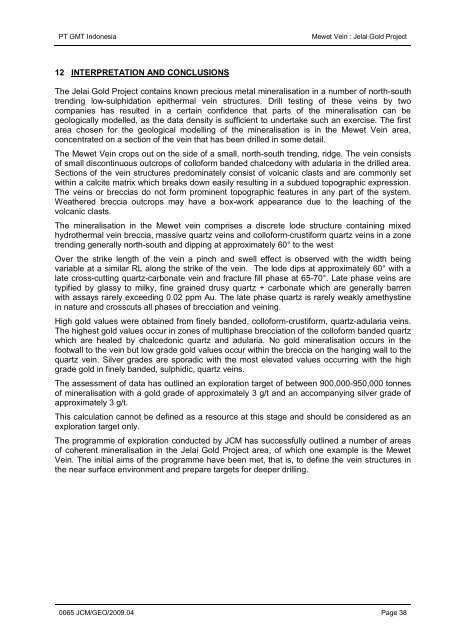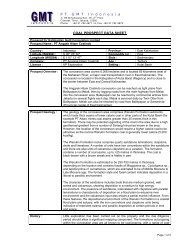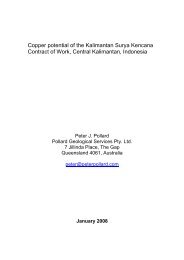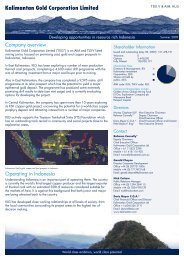Geology and mineralisation of the Mewet Vein, Jelai Gold Project ...
Geology and mineralisation of the Mewet Vein, Jelai Gold Project ...
Geology and mineralisation of the Mewet Vein, Jelai Gold Project ...
Create successful ePaper yourself
Turn your PDF publications into a flip-book with our unique Google optimized e-Paper software.
PT GMT Indonesia<br />
<strong>Mewet</strong> <strong>Vein</strong> : <strong>Jelai</strong> <strong>Gold</strong> <strong>Project</strong><br />
12<br />
INTERPRETATION AND CONCLUSIONS<br />
The <strong>Jelai</strong> <strong>Gold</strong> <strong>Project</strong> contains known precious metal <strong>mineralisation</strong> in a number <strong>of</strong> north-south<br />
trending low-sulphidation epi<strong>the</strong>rmal vein structures. Drill testing <strong>of</strong> <strong>the</strong>se veins by two<br />
companies has resulted in a certain confidence that parts <strong>of</strong> <strong>the</strong> <strong>mineralisation</strong> can be<br />
geologically modelled, as <strong>the</strong> data density is sufficient to undertake such an exercise. The first<br />
area chosen for <strong>the</strong> geological modelling <strong>of</strong> <strong>the</strong> <strong>mineralisation</strong> is in <strong>the</strong> <strong>Mewet</strong> <strong>Vein</strong> area,<br />
concentrated on a section <strong>of</strong> <strong>the</strong> vein that has been drilled in some detail.<br />
The <strong>Mewet</strong> <strong>Vein</strong> crops out on <strong>the</strong> side <strong>of</strong> a small, north-south trending, ridge. The vein consists<br />
<strong>of</strong> small discontinuous outcrops <strong>of</strong> coll<strong>of</strong>orm b<strong>and</strong>ed chalcedony with adularia in <strong>the</strong> drilled area.<br />
Sections <strong>of</strong> <strong>the</strong> vein structures predominately consist <strong>of</strong> volcanic clasts <strong>and</strong> are commonly set<br />
within a calcite matrix which breaks down easily resulting in a subdued topographic expression.<br />
The veins or breccias do not form prominent topographic features in any part <strong>of</strong> <strong>the</strong> system.<br />
Wea<strong>the</strong>red breccia outcrops may have a box-work appearance due to <strong>the</strong> leaching <strong>of</strong> <strong>the</strong><br />
volcanic clasts.<br />
The <strong>mineralisation</strong> in <strong>the</strong> <strong>Mewet</strong> vein comprises a discrete lode structure containing mixed<br />
hydro<strong>the</strong>rmal vein breccia, massive quartz veins <strong>and</strong> coll<strong>of</strong>orm-crustiform quartz veins in a zone<br />
trending generally north-south <strong>and</strong> dipping at approximately 60° to <strong>the</strong> west<br />
Over <strong>the</strong> strike length <strong>of</strong> <strong>the</strong> vein a pinch <strong>and</strong> swell effect is observed with <strong>the</strong> width being<br />
variable at a similar RL along <strong>the</strong> strike <strong>of</strong> <strong>the</strong> vein. The lode dips at approximately 60° with a<br />
late cross-cutting quartz-carbonate vein <strong>and</strong> fracture fill phase at 65-70°. Late phase veins are<br />
typified by glassy to milky, fine grained drusy quartz + carbonate which are generally barren<br />
with assays rarely exceeding 0.02 ppm Au. The late phase quartz is rarely weakly amethystine<br />
in nature <strong>and</strong> crosscuts all phases <strong>of</strong> brecciation <strong>and</strong> veining.<br />
High gold values were obtained from finely b<strong>and</strong>ed, coll<strong>of</strong>orm-crustiform, quartz-adularia veins.<br />
The highest gold values occur in zones <strong>of</strong> multiphase brecciation <strong>of</strong> <strong>the</strong> coll<strong>of</strong>orm b<strong>and</strong>ed quartz<br />
which are healed by chalcedonic quartz <strong>and</strong> adularia. No gold <strong>mineralisation</strong> occurs in <strong>the</strong><br />
footwall to <strong>the</strong> vein but low grade gold values occur within <strong>the</strong> breccia on <strong>the</strong> hanging wall to <strong>the</strong><br />
quartz vein. Silver grades are sporadic with <strong>the</strong> most elevated values occurring with <strong>the</strong> high<br />
grade gold in finely b<strong>and</strong>ed, sulphidic, quartz veins.<br />
The assessment <strong>of</strong> data has outlined an exploration target <strong>of</strong> between 900,000-950,000 tonnes<br />
<strong>of</strong> <strong>mineralisation</strong> with a gold grade <strong>of</strong> approximately 3 g/t <strong>and</strong> an accompanying silver grade <strong>of</strong><br />
approximately 3 g/t.<br />
This calculation cannot be defined as a resource at this stage <strong>and</strong> should be considered as an<br />
exploration target only.<br />
The programme <strong>of</strong> exploration conducted by JCM has successfully outlined a number <strong>of</strong> areas<br />
<strong>of</strong> coherent <strong>mineralisation</strong> in <strong>the</strong> <strong>Jelai</strong> <strong>Gold</strong> <strong>Project</strong> area, <strong>of</strong> which one example is <strong>the</strong> <strong>Mewet</strong><br />
<strong>Vein</strong>. The initial aims <strong>of</strong> <strong>the</strong> programme have been met, that is, to define <strong>the</strong> vein structures in<br />
<strong>the</strong> near surface environment <strong>and</strong> prepare targets for deeper drilling.<br />
0065 JCM/GEO/2009.04 Page 38










